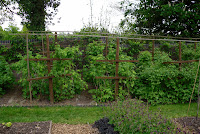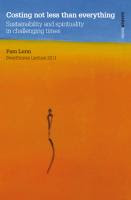The study of this kind of thing is called 'discourse analysis', and there's a very useful little book about it, applied specifically to environmental issues:
John S Dryzek
The Politics of the Earth: environmental discourses
(Oxford University Press, 2nd edition, 2005)
In a way, this is a textbook - but don't let that put you off! It's well laid-out, accessible and very helpful in understanding those dead-end conversations, and working out how to handle them differently.
Dryzek explains the discourse approach, and then starts with a simple classification of environmental discourses: on one axis, they might be 'prosaic' or 'imaginative'; on the other axis they could be 'reformist' or 'radical'. This gives us four basic positions (p.15):
reformist radical
prosaic problem solving (ii) survivalism (i)
imaginative sustainability (iii) green radicalism (iv)
He then gives us the elements that he will look at within any of these positions (p.19):
- what are the basic entities recognised (or constructed)?
- what are the assumptions about natural relationships?
- what/who are the agents and their motives?
- what are the key metaphors and rhetorical devices?
As examples of 'metaphors and rhetorical devices' he offers:
- spaceships (as in 'spaceship earth')
- the grazing of common lands (as in 'the tragedy of the commons')
- machines (nature is like a machine that we can tinker with)
- organisms (nature is a complex organism that grows and develops)
- war (as in war against nature)
- goddesses (treating nature as a benign mother)
. . . and so on.
Dryzek then offers us a checklist for assessing the effects of any particular discourse (p.21):
- what are the politics associated with this discourse?
- what are the effects on policies of governments?
- what are the effects on institutions?
- what are the social andcultural impacts?
- what arguments do critics of the discourse use?
- what are the flaws revealed by evidence and argument?
These two checklists of basic categories will be used to examine each of the 4 positions above.
In the next chapter, he discusses the position he has called 'survivalism' (i) and summarises it (p.41) using the categories he has already set out:
1. Basic entities
- finite stocks of resources
- carrying capacity of ecosystems
- population
- elites
2. Assumptions about natural relationships
- conflict
- hierarchy and control
3. Agents and their motives
- elites; motivation is up for grabs
4. Key metaphors and other rhetorical devices
- overshoot and collapse
- commons
- spaceship earth
- lily pond (see below!)
- virus
- computers
- images of doom/redemption
NB: The Lily Pond Metaphor
This is often used as a mtaphor for population issues:
* If a pond lily doubles everyday and it takes 30 days to completely cover a pond, on what day will the pond be 1/2 covered? [answer: day 29!]
* What will begin to happen at one minute past the 30th day?
Next, Dryzek looks at what he names the Promethean discourse - growth forever (a version of survivalism) - and summarises it under the same categories (p.61):
1. Basic entities
- nature as only brute matter
- markets
- prices
- energy
- technology
- people
2. Assumptions about natural relationships
- hierarchy of humans over everything else
- competition
3. Agents and their motives
- everyone, motivated by material self-interest [remember: this is the assumption made by people who take this position]
4. Key metaphors and other rhetorical devices
- mechanistic
- following trends
Dryzek next examines attitudes to solving environmental problems (ii), and looks at three in detail: 'leave it to the experts', 'leave it to the people', 'leave it to the markets'.
A: Leave it to the experts - administrative rationalism
1. Basic entities
- liberal capitalism
- administrative state
- experts
- managers
2. Assumptions about natural relationships
- nature subordinate to human probem solving
- people subordinate to state
- experts and managers to control state
3. Agents and their motives
- experts and managers; motivated by public interest, defined as a single, unified thing
4. Key metaphors and other rhetorical devices
- mixture of concern and reassurance
- the 'administrative mind'
B: Leave it to the people - democratic pragmatism
1. Basic entities
- liberal capitalism
- citizens
2. Assumptions about natural relationships
- equality among citizens
- interactive political relationships, mixing competition and co-operation
3. Agents and their motives
- many different agents
- motivation a mix of material self-interest and multiple conceptions of public interest.
4. Key metaphors and other rhetorical devices
- public policy as an outcome of forces acting
- policy is like scientific experimentation
- thermostats
- networks
C: Leave it to the markets - economic rationalism
1. Basic entities
- 'homo economicus'
- markets
- prices
- property
- governments (not citizens)
2. Assumptions about natural relationships
- competition
- hierarchy based on expertise
- subordination of nature
3. Agents and their motives
- 'homo economicus': self-interested
- some government officials must be motivated by public interest
4. Key metaphors and other rhetorical devices
- mechanistic
- stigmatise regulation as 'command and control' [NB: or, in Britain, as 'the nanny state']
- talk about 'freedom'
- horror stories
Now moving on to 'sustainability' (iii), Dryzek focuses on two versions of this position: 'environmentally benign growth' and 'industrial society and beyond'.
A: Environmentally benign growth - sustainable development
1. Basic entities
- nested and networked social and ecological systems
- capitalist economy
- ambiguity concerning the existence (or not) of limits
2. Assumptions about natural relationships
- co-operation
- nature is subordinate
- economic growth, environmental protection, distributive justice, and long-term sustainability all belong together
3. Agents and their motives
- many agents at different levels, transnational and local as well as the state; motivated by the public good
4. Key metaphors and other rhetorical devices
- organic growth
- nature as natural capital
- connection to progress
- reassurance
B: Industrial society and beyond - ecological modernisation
1. Basic entities
- complex systems
- nature as waste treatment plant
- capitalist economy
- the state
2. Assumptions about natural relationships
- partnerships encompassing government, business, environmentalists, scientists
- subordination of nature
- environmental protection and economic prosperity go together
3. Agents and their motives
- partners; motivated by public good
4. Key metaphors and other rhetorical devices
- tidy household
- connection to progress
- reassurance
And finally, Dryzek turns to 'green radicalism' (iv) and considers two dimensions of this: 'changing people' and 'changing society'.
'Changing people - green consciousness' encompasses: 'deep ecology', 'ecofeminism', 'ecological citizenship', 'lifestyle greens' and 'eco-theology'. While there are obviously differencces between these positions, he identifies certain common characteristics:
1. Basic entities
- global limits
- nature
- unnatural practices (eg: core sensibilities of industrial society)
- ideas (eg: idealism, change of consciousness)
2. Assumptions about natural relationships
- natural relationships between humans and nature that have been violated
- equality across people and nature
3. Agents and their motives
- human subjects, some more ecologically aware than others
- agency can exist in nature, too
4. Key metaphors and other rhetorical devices
- wide range of biological and organic metaphors
- passion
- appeals to emotions, intuitions
'Changing society - green politics' encompasses: 'green parties', 'social ecology', 'red and green' (green socialism), 'environmental justice', 'environmentalism of the global poor', 'anti-globalisation and global justice' and 'animal liberation'. Again, there are differences but also commonalities:
1. Basic entities
- global limits
- nature as complex ecosystems
- humans with broad capacities
- social, economic, and political structures
2. Assumptions about natural relationships
- equality among people
- complex interconnections between humans and nature
3. Agents and their motives
- many individual and collective actors, multidimensional motivation
- agency in nature downplayed though not necessarily denied
4. Key metaphors and other rhetorical devices
- organic metaphors
- appeals to social learning
- link to progress
What, asks Dryzek, would count as a 'conclusion' to this examination? He writes (p.232):
Any intelligent approach to environmental issues demands two things. The first is a dynamic, structural-level analysis of the liberal capitalist political economy, where it might be headed, and what realistically can be done to alter this trajectory to more ecologically benign ends . . . The second quality is the capacity to facilitate and engage in social learning in an ecological context. Environmental issues feature high degrees of uncertainty and complexity, which are magnifeid as ecological systems interact with social, economic, and political systems. Thus we need institutions and discourses which are capable of learning - not least about their own shortcomings.One final thought from me: anyone reading this who is familiar with Spiral Dynamics might like to try mapping those categories onto Dryzek's - it's quite illuminating.
If the relationship between language and ecology is of interest to you, you might like to explore the Language and Ecology Research Forum.
* * * * *
If you want to post a comment, and are having technical difficulties, you can email your comment to me at Good.Lives@woodbrooke.org.uk and I can post it for you.If you are reader from outside the UK, please remember to post your comment in English - I won't post anything if I don't know what it says!
* * * *






























